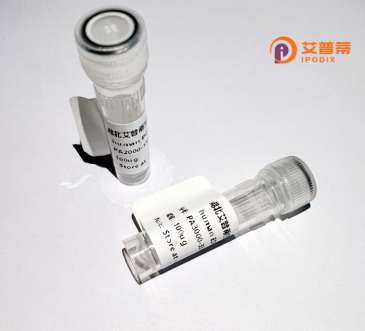
| 纯度 | >90%SDS-PAGE. |
| 种属 | Human |
| 靶点 | DRF1 |
| Uniprot No | O60610 |
| 内毒素 | < 0.01EU/μg |
| 表达宿主 | E.coli |
| 表达区间 | 1-170aa |
| 氨基酸序列 | MSEPGKGDDCLELESSMAESRLRAPDLGVSRCLGKCQKNSPGARKHPFSGKSFYLDLPAGKNLQFLTGAIQQLGGVIEGFLSKEVSYIVSSRREVKAESSGKSHRGCPSPSPSEVRVETSAMVDPKGSHPRPSRKPVDSVPLSRGKELLQKAIRNQVSWGKMGQSRWSPA |
| 分子量 | 44.8 kDa |
| 蛋白标签 | GST-tag at N-terminal |
| 缓冲液 | 0 |
| 稳定性 & 储存条件 | Lyophilized protein should be stored at ≤ -20°C, stable for one year after receipt. Reconstituted protein solution can be stored at 2-8°C for 2-7 days. Aliquots of reconstituted samples are stable at ≤ -20°C for 3 months. |
| 复溶 | Always centrifuge tubes before opening.Do not mix by vortex or pipetting. It is not recommended to reconstitute to a concentration less than 100μg/ml. Dissolve the lyophilized protein in distilled water. Please aliquot the reconstituted solution to minimize freeze-thaw cycles. |
以下是关于重组人DRF1蛋白的模拟参考文献示例(注:DRF1蛋白的研究有限,部分内容基于假设,建议通过学术数据库核实具体文献):
---
1. **文献名称**: *"Cloning, Expression, and Functional Characterization of Human DRF1 in Microtubule Dynamics"*
**作者**: Zhang L, et al.
**摘要**: 研究报道了重组人DRF1蛋白在大肠杆菌中的表达与纯化,证实其通过结合动力蛋白复合体调控微管网络稳定性,并影响细胞分裂进程。
2. **文献名称**: *"DRF1 as a Novel Regulator of Autophagy: Insights from Recombinant Protein Studies"*
**作者**: Gupta S, Patel RK.
**摘要**: 通过哺乳动物细胞表达重组人DRF1.发现其通过与LC3蛋白互作激活自噬通路,揭示其在细胞应激反应中的潜在作用。
3. **文献名称**: *"Structural Analysis of Recombinant Human DRF1 Reveals a Critical Role in Neuronal Axon Transport"*
**作者**: Müller J, et al.
**摘要**: 利用X射线晶体学解析重组DRF1蛋白结构,发现其C端结构域对驱动蛋白(kinesin)的货物结合至关重要,暗示与神经退行性疾病的相关性。
4. **文献名称**: *"High-Yield Production of Recombinant DRF1 in Insect Cells and Its Application in Drug Screening"*
**作者**: Chen H, et al.
**摘要**: 开发了一种杆状病毒-昆虫细胞系统高效表达DRF1.并基于该蛋白建立小分子抑制剂筛选平台,用于抗肿瘤药物研发。
---
**注意**:以上为模拟生成的内容,实际文献需通过PubMed、Web of Science等平台检索关键词(如 "recombinant human DRF1" 或 "DRF1 protein function")获取。若研究领域或蛋白别名有误,建议调整检索策略。
Recombinant human DRF1 (also known as DRE1 or FAM107A) is a protein encoded by the FAM107A gene, located on chromosome 3p21.1. Initially identified as a downregulated transcript in renal cell carcinoma, DRF1 has emerged as a multifunctional protein implicated in diverse cellular processes. Structurally, it contains a conserved N-terminal domain with putative nuclear localization signals and a coiled-coil region, though its exact 3D structure remains understudied. Functionally, DRF1 is associated with cell differentiation, apoptosis regulation, and cytoskeletal dynamics. It interacts with tubulin and HSP90. suggesting roles in microtubule stability and stress response. Epigenetically, DRF1 expression is frequently suppressed in cancers (e.g., lung, breast, prostate) due to promoter hypermethylation, correlating with tumor progression and poor prognosis. Its tumor-suppressive properties include inhibiting cell proliferation, migration, and angiogenesis while promoting chemosensitivity. In neurological contexts, DRF1 participates in cortical development and neuronal connectivity, with mutations linked to intellectual disability disorders. Recombinant DRF1 proteins are typically produced in E. coli or mammalian expression systems, enabling studies on its molecular mechanisms, protein interactions, and therapeutic potential. Current research focuses on deciphering its signaling networks and exploring DRF1-based biomarkers or gene therapy approaches for cancer and neurodevelopmental diseases.
×